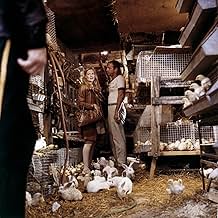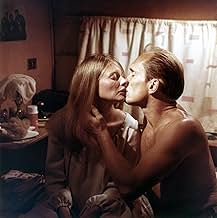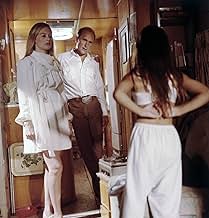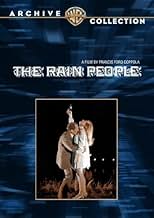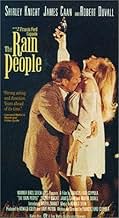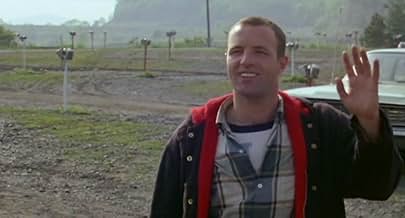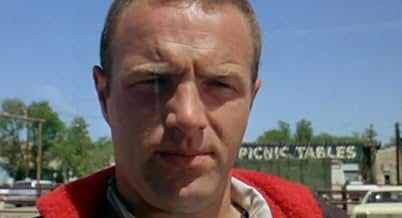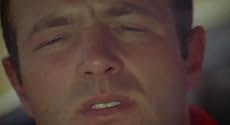Sentindo-se prisioneira de uma vida sem sentido, mulher grávida foge de casa numa manhã chuvosa. Ela dá carona para um jogador de futebol simplório com quem acaba se envolvendo.Sentindo-se prisioneira de uma vida sem sentido, mulher grávida foge de casa numa manhã chuvosa. Ela dá carona para um jogador de futebol simplório com quem acaba se envolvendo.Sentindo-se prisioneira de uma vida sem sentido, mulher grávida foge de casa numa manhã chuvosa. Ela dá carona para um jogador de futebol simplório com quem acaba se envolvendo.
- Direção
- Roteirista
- Artistas
- Prêmios
- 1 vitória no total
- Ellen
- (as Laurie Crews)
- Farmer
- (não creditado)
- Gordon's Wife
- (não creditado)
Avaliações em destaque
For expansive post-war couples the suburbs were liberating; but a generation later and younger folks like Knight felt confined. This is a 60's road picture feminine style. When Americans get restless or unhappy, they head westward in frontier tradition. So why shouldn't a woman, even when alone and vulnerable. The acting here is outstanding, and it better be since character carries the story or what there is of it. I really like Caan who shows why less is sometimes more. And get a load of those desolate roadsides, no cosmetic Hollywood here. Too bad the film's so obscure in the Coppola canon. All in all, it's a telling reflection of a restless time, perhaps even of what some call the human condition. However, I can understand why it's not everyone's cup of tea, and certainly a long way from Coppola's next, The Godfather (1972).
"The Rain People" (1969) was made three years before Francis Ford Coppola became famous with "The Godfather." It was his first movie in which he had total creative control, writing and directing on the road without producers breathing down his neck. The story was inspired by Francis' mother curiously leaving home for a few days when he was a kid. It's about a woman's haphazard search for freedom from the manacles of domestic life. Unlike the domineering male protagonists of "Patton" (which he wrote), the Corleone patriarchs and Kurtz in "Apocalypse Now," Coppola shows us here several females manipulating men: Natalie with Kilgannon, Gordon and even Vinny; Ellen with Kilgannon and her father; and Rosalie with her dad.
Interestingly, it's the express opposite of Francis' previous movie, the fun "Finian's Rainbow," which was based on the 1947 Broadway hit. One is an energetic musical with a large cast while this has an everyday, depressing tone, made with a small cast & crew. While neither were successful at the box office, they both went on to garner cult followings after Coppola's great success in the 1970s-90s (of course he had a few movies that didn't do so well, but what else is new?).
I can see where many viewers would find "The Rain People" dull, but it features a daring premise and has historical significance, not to mention some notable cast members. Plus, it's a quality period piece for the late '60s. In regards to the commendable premise, Natalie loves her husband, but is uncertain about the responsibility of having his child and so instinctively flees the scene. Ironically, Killgannon becomes her surrogate 'child' on her road odyssey wherein she struggles with her obligations.
Concerning the 'historical significance,' the industry proudly cites "Stand Up and Be Counted" as the first flick to address women's liberation, which it overtly does. But this came out three years prior and few people noticed at the time because it's so covert. It was ahead of its time.
Francis originally intended to include a scene at the end to clear up what Natalie decides to do from there, but it wasn't needed because everything is explained in her monologue. Listen.
It runs 1 hour, 41 minutes, and was shot over the course of five months in several American states with a 10-person crew (along with a smattering of locals). The locations include: Garden City (opening shot), Manhattan (Lincoln Tunnel) & Hofstra University, New York; the Pennsylvania Interstate; Harrisonburg, Virginia (restaurant scene); Clarksburg (the drive-in theater) & Weston, West Virginia; Chattanooga, Tennessee (the parade); Brule (the burning house) & Ogallala (the reptile ranch), Nebraska; and other places for exterior shots.
GRADE: B/B-
Coppola says it was a personal project and there are some people who think it's his first masterpiece but it wasn't a hit and despite Coppola's name on the credits has become something of a lost movie. Knight is excellent as she mopes about and, you might say, teasing any man who comes her way while Duvall and especially Caan match her at every turn. You could say it's a quintessential American film of its time, a 'movie-brat' movie if there ever was one and Coppola's first real 'signature' picture, (though I do have a soft-spot for the wonderful "Finian's Rainbow" which preceeded it). If you do get a chance to track this down it is certainly well worth seeing.
The film, however, with a strong debut for James Caan, remains effective and affecting. It's a great showcase for the talent that Ms. Knight has demonstrated her entire career--on television, in movies and on the stage, where she won the Tony for "Kennedy's Children."
This film has aged well.
Você sabia?
- CuriosidadesThe parade scene was filmed in Chattanooga, Tennessee on Memorial Day. The students in the band were not aware of what was happening. In fact, reading the lips of a majorette, she can be seen asking, "Who was that guy?" as James Caan was weaving through the parade.
- Erros de gravaçãoWhen Natalie first leaves her husband, she drives into a tunnel and emerges from on the west side of Manhattan. That is, she has driven east through the Lincoln Tunnel, presumably heading east. But immediately after, she stops at a phone booth to call her husband, saying she is in Pennsylvania, which is in the opposite direction. Had the intention to suggest a westward journey, she could have driven west through the tunnel to emerge in New Jersey.
- Citações
Natalie Ravenna: You are the most obedient man I've ever met in my life. Look at me. Aren't you?
Jimmy Kilgannon: Yes.
Natalie Ravenna: Aren't you?
Jimmy Kilgannon: Yes.
Natalie Ravenna: Aren't you?
Jimmy Kilgannon: Yes.
Natalie Ravenna: Aren't you?
Jimmy Kilgannon: Yes.
Natalie Ravenna: Alright.
Principais escolhas
- How long is The Rain People?Fornecido pela Alexa
Detalhes
- Data de lançamento
- País de origem
- Idioma
- Também conhecido como
- Dos almas en pugna
- Locações de filme
- Chattanooga, Tennessee, EUA(Veterans Day parade)
- Empresas de produção
- Consulte mais créditos da empresa na IMDbPro
Bilheteria
- Orçamento
- US$ 750.000 (estimativa)
Contribua para esta página



